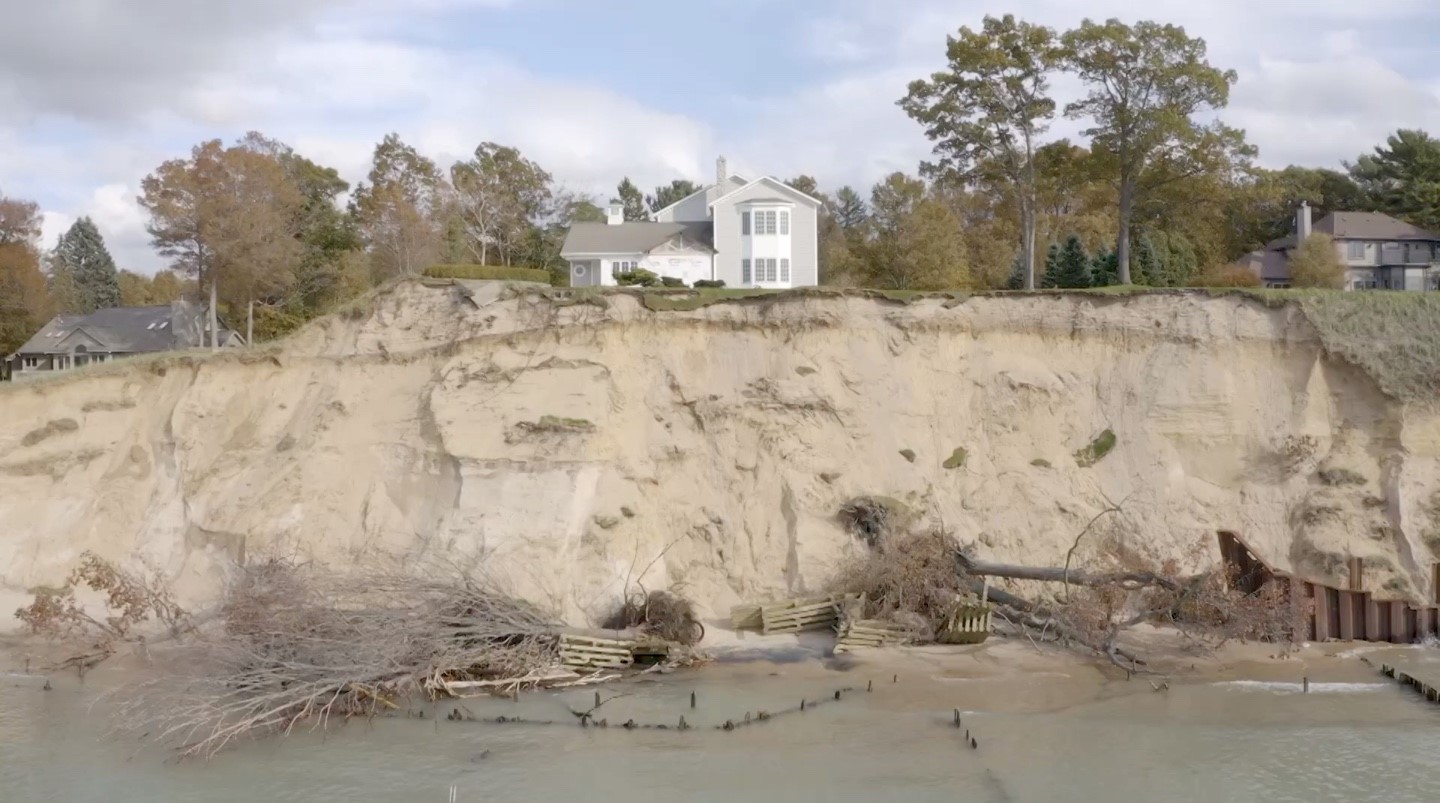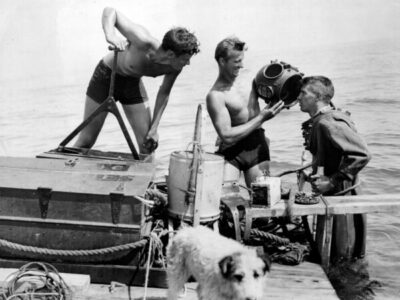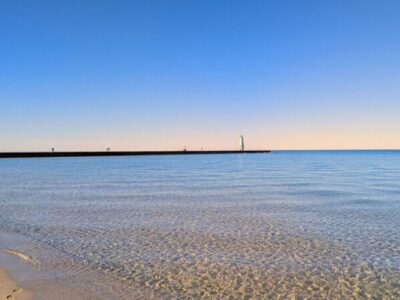
Climate change-fueled weather such as extreme storms will provide a direct threat to contaminated waste storage sites, nuclear power plants and industrial facilities at multiple sites on the shores of Lake Michigan, according to a new report.
The 63-mile corridor from Gary, Indiana, through Illinois to the Wisconsin border is particularly at risk. It includes Gary’s heavily industrialized lakefront; Waukegan, Illinois, with its Superfund sites; and to the north, the now-closed Zion Nuclear Power plant with waste stored near the lakeshore.
The report was produced by the Environmental Law and Policy Center, a Chicago-based non-profit.
Among other locations cited in the report are the wastewater treatment plant in South Haven, Michigan, where flooding is already common as well as wastewater treatment plants and a coal plant in Sheboygan, Wisconsin.
Watch Great Lakes Now’s segment on South Haven’s flooding problems here:
The at-risk sites were determined using data provided by the National Oceanic and Atmospheric Administration that illustrated how far flood waters could reach if lake levels surpass current records.
The report called for significant financial investments from all levels of government and for examination of existing policies with the goal of accounting for the new threats.
“It’s time for us to rethink the Great Lakes shoreline’s built environment to reassess the risks from industrial facilities with hazardous materials, as well as to our homes,” said Howard Learner, ELPC’s executive director.
The report’s recommendations include a call for cleanup of toxic shoreline sites and a reassessment of zoning and planning policies that are currently based on historic lake levels instead of the extreme fluctuations we are seeing now.
Not mentioned in the report is the Pacific Palisades nuclear power plant on the shore of Lake Michigan in western Michigan. The plant’s owners have shut the plant down, but Michigan officials are working with the Biden administration to keep it open to support the state’s climate change initiatives, according to Bridge Michigan reporting.
ELPC’s Kiana Courtney told Great Lakes Now that for the Palisades plant, NOAA modeling didn’t address whether the infrastructure that protects the shoreline is sound.
“The modeling assumes the berms and sea walls are sound structures when we know at least two examples of where their aging structure is problematic,” said Courtney, a staff attorney and co-author of the report.
Asked about the threat to the Palisades plant from climate change, Michigan’s Department of Environment, Great Lakes and Energy deferred to the federal Nuclear Energy Commission.
EGLE and the state “recognize the Nuclear Energy Commission’s appropriate oversight responsibility. The plant is now permanently shut down, with spent fuel – and current fuel, soon – stored in dry casks,” agency spokesperson Jeff Johnston told Great Lakes Now.
Johnston cited the U.S. Nuclear Regulatory Commission website for storage of spent fuel which says cask systems “must resist earthquakes, projectiles, tornadoes, floods, temperature extremes and other scenarios.”
Since implementation in 1986, storage casks have released no radiation that affected the public or the contaminated environment, according to the NRC.
“Anticipate the worst”
The climate change threat to the shores of the Great Lakes and Michigan concerns Rob Sisson, former mayor of Sturgis, Michigan, and now a commissioner with the International Joint Commission, the U.S. and Canadian organization that advises the two governments on trans-border water issues.
A priority for Sisson is the threat from nuclear waste stored on shorelines. The commission’s Great Lakes Water Quality Board recently called for nuclear power plant operators and regulators to plan for coastal climate impacts when designing and locating spent fuel storage facilities, Sisson told Great Lakes Now.
There are growing inventories of spent nuclear fuel at every operating nuclear power plant along the shores of the Great Lakes, the Water Quality Board’s report said.
“We have to be pessimistic and anticipate the worst. The entire lower peninsula of Michigan is basically a sand dune,” said Sisson, who added that in the recent past, high water combined with storms and wind wreaked havoc on shorelines.
“We should expect danger in the future if we don’t address the spent fuel that’s stored on the coast lines,” Sisson said.
Looking for solutions
The Alliance for the Great Lakes CEO Joel Brammeier called on the U.S. Army Corps of Engineers to expedite the start and completion of its Great Lakes Coastal Resiliency Study.
The study will involve multiple federal agencies and the Great Lakes states, and will make recommendations to allow Great Lakes shores to withstand and recover from increased extreme weather events.
The study should be used “to identify large-scale opportunities for rebuilding and restoring coastal systems using natural solutions, and address damage done by building too close to and hardening the shoreline,” Brammeier told Great Lakes Now.
Brammeier, who has been working on shoreline issues for 20 years, said “this is a critical step to authorizing new projects at the scale the Great Lakes deserve.”
EGLE’s Johnston said “it’s crucial that utility plant owners and operators, as well as other lakeshore property owners and the state in general, prepare for unprecedented extreme weather events driven by climate change.”
Michigan’s climate plan for carbon neutrality by 2050 is designed to avert the worst impacts of climate change, according to Johnston who said, “Michigan currently spends millions of dollars annually responding to climate-related emergencies and other impacts.”
The IJC’s Sisson praised Gov. Gretchen Whitmer and former Gov. Rick Snyder for being “forward-thinking” for inventorying and assessing municipal infrastructure around the state.
To fund the cleanup and resiliency work cited in its report, ELPC called for the popular Great Lakes Restoration Initiative to evaluate projects for at-risk sites on Great Lakes shores and to tap the $1 billion from President Biden’s infrastructure bill. That windfall was designated to accelerate cleanup of legacy toxic sites from 1987 Areas of Concern list. It is unclear if that funding can be used for other purposes and the EPA’s Great Lakes office did not respond to requests to clarify.
Catch more news about nuclear waste at Great Lakes Now:
Public Perception: When it comes to nuclear waste in the Great Lakes region, what counts as safe?
Featured image: Lake Michigan shorelines are eroding. (Great Lakes Now Episode 1010/Photo courtesy of MLive Media Group)




